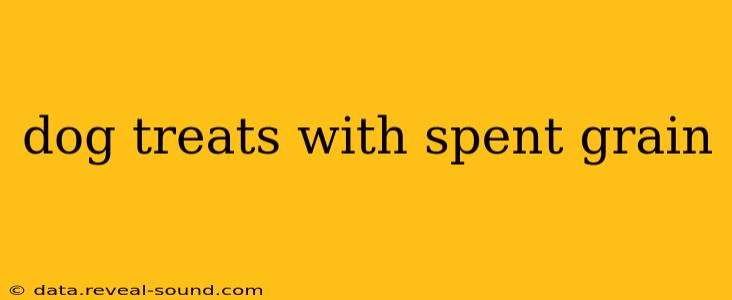Spent grain, the byproduct of beer brewing, is a surprisingly versatile ingredient with numerous uses, including making nutritious and tasty dog treats. This byproduct, often discarded, is packed with fiber and nutrients beneficial for canine health. This comprehensive guide explores the benefits of using spent grain in dog treats, provides recipes, and addresses common concerns.
Why Use Spent Grain in Dog Treats?
Spent grain offers several advantages when incorporated into your dog's diet:
-
High in Fiber: It's an excellent source of dietary fiber, promoting healthy digestion and preventing constipation. Fiber also contributes to a feeling of fullness, potentially aiding weight management in dogs prone to obesity.
-
Nutrient-Rich: Though the brewing process extracts some nutrients, spent grain retains valuable vitamins and minerals, providing a boost to your dog's overall health. These include B vitamins, antioxidants, and trace minerals.
-
Sustainable and Eco-Friendly: Utilizing spent grain reduces waste and promotes sustainable practices within the brewing industry. By repurposing this byproduct, you contribute to environmental consciousness.
-
Economical: Spent grain is often available for free or at a low cost from local breweries. This makes it a budget-friendly ingredient for homemade dog treats.
What are the potential downsides of using spent grain in dog treats?
While generally safe, there are a few considerations:
-
Mold: Ensure the spent grain is fresh and stored properly to prevent mold growth. Moldy spent grain should never be fed to your dog.
-
High Fiber Content: While fiber is beneficial, excessive intake can cause digestive upset in some dogs. Introduce spent grain gradually into your dog's diet to monitor their tolerance.
-
Potential Allergens: Although uncommon, some dogs may have an allergic reaction to spent grain. Watch for signs of allergies such as itching, vomiting, or diarrhea.
-
Not a Complete Diet: Spent grain should be considered a supplementary ingredient, not a replacement for a complete and balanced dog food.
How to Make Spent Grain Dog Treats: Recipes & Tips
Here are two simple recipes to get you started:
Recipe 1: Simple Spent Grain Biscuits
- 1 cup spent grain, dried and finely ground
- 1/2 cup whole wheat flour
- 1/4 cup water
- 1 egg (optional, for binding)
Instructions:
- Preheat oven to 350°F (175°C).
- Combine all ingredients in a bowl and mix thoroughly.
- Roll out the dough to about 1/4 inch thickness.
- Use cookie cutters to create desired shapes.
- Bake for 15-20 minutes, or until golden brown.
- Let cool completely before serving to your furry friend.
Recipe 2: Spent Grain and Peanut Butter Bites
- 1 cup spent grain, dried and finely ground
- 1/2 cup peanut butter (xylitol-free!)
- 1/4 cup rolled oats
- 1 egg (optional)
- 1/4 cup water
Instructions:
- Preheat oven to 350°F (175°C).
- Mix all ingredients thoroughly.
- Roll the mixture into small balls.
- Bake for 10-15 minutes, or until lightly browned.
- Let cool completely.
Important Note: Always supervise your dog while they are eating treats. Choose xylitol-free peanut butter, as xylitol is toxic to dogs. Adjust baking time depending on your oven and desired consistency.
Can I feed my dog raw spent grain?
No, it's not recommended to feed your dog raw spent grain. Raw spent grain can harbor bacteria and may cause digestive upset. Always dry and/or bake the spent grain before incorporating it into treats.
Is spent grain safe for all dogs?
While generally safe, introducing spent grain gradually and monitoring your dog's reaction is crucial. Consult your veterinarian if you have concerns about allergies or potential dietary restrictions for your dog.
Where can I get spent grain for dog treats?
Many local breweries are happy to donate or sell their spent grain. Contact your local breweries to inquire about availability. Be sure to confirm that the grain has been properly cleaned and dried.
By following these guidelines and recipes, you can create delicious and healthy dog treats that are both rewarding for your furry friend and environmentally responsible. Remember to always consult your veterinarian before introducing new foods into your dog’s diet, especially if they have pre-existing health conditions.
